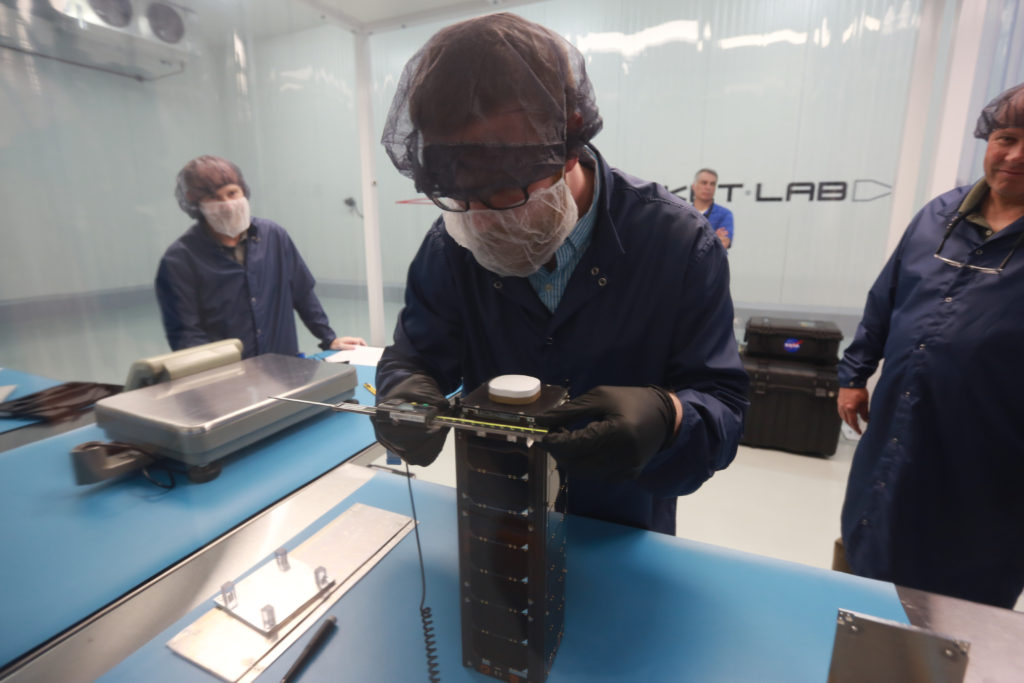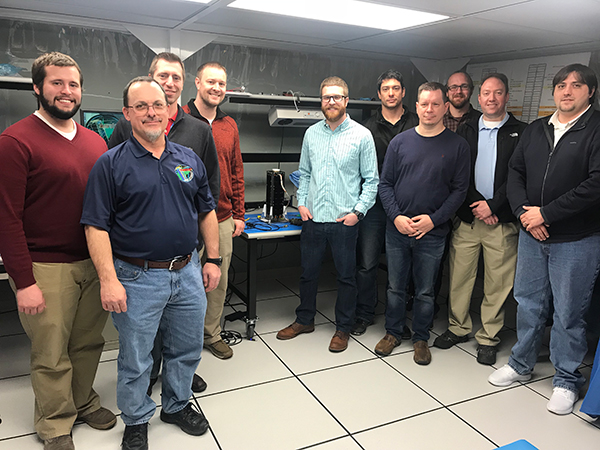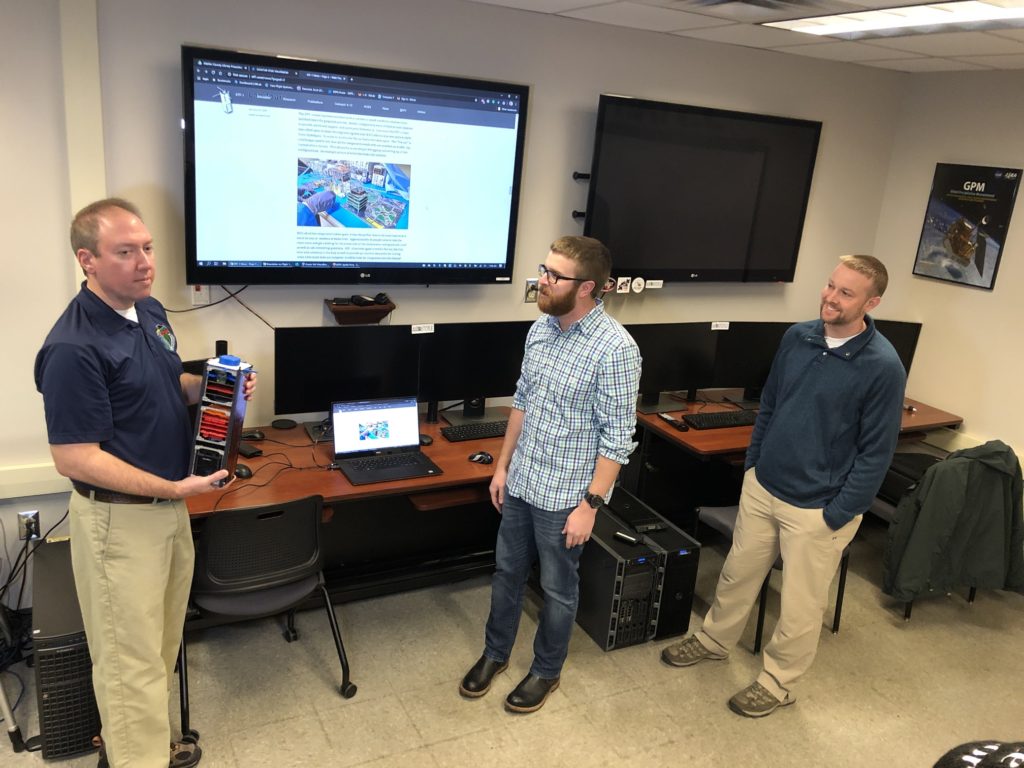By John Dahlia
Marcus Fisher, Justin Morris, Scott Zemerick, Matt Grub and Mark Suder. These men shared a childhood dreams to propel their beloved Mountain State into space—and it came true.
Launching West Virginia’s First Spacecraft
West Virginia’s first spacecraft, Simulation to Flight-1 (STF-1), launched into orbit on December 16, 2018, on the first-ever NASA Venture Class Launch Services mission via the Rocket Lab Electron Rocket. The launch took place from New Zealand’s Mahia Peninsula, and STF-1 was one of 10 small satellites deployed by the California-based Rocket Lab’s Electron vehicle as part of NASA’s Educational Launch of Nanosatellites (ELaNa-19) mission. First contact was achieved a few days later.

“I don’t think words can express the amount of happiness and the sense of accomplishment that came across the team during the first successful communications,” says NASA Computer Engineer Justin Morris.
Today, more than 600 days and 9,200 orbits around the globe later, STF-1 continues to exceed mission expectations.
“We far surpassed our estimates for length of the mission,” says STF-1 Lead Engineer Matt Grubb, referring to the typical three-month average for most small satellite or CubeSat missions.

For NASA Independent Verification and Validation (IV&V) Program Director Gregory Blaney, beating the odds and going beyond expectations is typical for a NASA program.
“In this case, it means to me that West Virginia entities have the skills and capability to build and test small satellites in addition to advancing the development processes,” he says.
Like most members of the STF-1 team, Blaney has strong ties to the Mountain State. He was born in Morgantown but grew up on a farm a few miles over the state line in southwestern Pennsylvania. He worked at the NASA Goddard Space Flight Center in Maryland as a network director providing services for missions such as the Space Shuttle, Hubble Space Telescope and classified operations before transferring to NASA’s IV&V Program in West Virginia, where he held numerous positions leading up to being named director in late 2009.
Building the Team
The spacecraft, also called a SmallSat or CubeSat, is no bigger than a standard breadbox, measuring a meager 34 by 10 by 10 centimeters and weighing under 4 kilograms. The team that dreamed it up evolved from a unique public, private and academic partnership involving the NASA IV&V Program, West Virginia University (WVU), the NASA West Virginia Space Grant Consortium, High Technology Foundation and a small, West Virginia-based private company called TMC Technologies.
“Marcus Fisher was one of the earliest proponents of developing West Virginia’s first spacecraft,” says STF-1 Engineer Scott Zemerick.
However, Fisher, a NASA IV&V Program chief engineer and Goddard Space Flight Center Senior Technical Fellow, says the idea originated from NASA West Virginia Space Grant Consortium Director Majid Jaridi.
“Knowing that West Virginia was one of the states that had never launched any assets into space, it was easy to decide that we need to act fast and make use of this opportunity,” Jaridi recalls.
A handful of meetings with NASA and other potential partners later, Fisher told Jaridi he was ready to pull the trigger. What followed was an effort to build a coalition of partners and win the dollars needed to launch a SmallSat mission from NASA’s CubeSat Launch Initiative. According to Zemerick, the project became real when their proposal was chosen in early 2015.

WVU would provide the four experiments, and the team at NASA IV&V’s Jon McBride Software Testing and Research Lab would perform the spacecraft engineering, which included hardware, software, integration, testing and operations. According to Blaney, STF-1’s primary mission and technological driver was to test a unique simulation and modeling software called NASA Operational Simulator for Small Satellites, or NOS3.
“NOS3 is a one-of-a-kind test and simulation capability because it is a software-only system, which makes it extremely efficient, effective and cost advantageous—once created, you can make copies for almost free,” he says.
Proof of Concept
According to Michael Swartwout, a leading authority on why CubeSat missions fail, STF-1’s success for a first-time effort is very uncommon.
“I can tell you that 600 days of operations is a big deal for most programs— especially for first-time universities,” Swartwout says, referring to the number of days STF-1 has been operating at near-perfect levels in lower earth orbit.
Swartwout’s research in CubeSat mission assurance has become a life-long pursuit going back to the mid-1990s, when he attended Stanford University as a graduate student. He was at a conference and ran into a speaker who was summarizing the results of a multi-spacecraft launch claiming most of the student-built spacecraft failed.

“As a recently-graduated student with a functional spacecraft, I took that personally,” says Swartwout. “I wasn’t offended that the speaker said those particular spacecraft failed—he was correct, after all. What bothered me was that he assumed most student satellites failed, and that’s what I could prove. So I gathered all the data and decided to present it at the next year’s conference.”
Two decades and scores of published papers later, Swartwout is routinely asked to present his research on CubeSat mission assurance. The most recent was in June 2020 at the NASA Goddard Space Flight Center’s Electronics Technology Workshop. Those attending included representatives from NASA and both the European and Japanese Space Agencies.
“From the first proto-CubeSats launched in the year 2000 until the end of 2019, there were 1,184 CubeSats flown by 287 organizations from all over the world,” says Swartwout. “Out of those numbers, two-thirds, or 54 of 80, first-time professional organizations were successful.”
But the numbers are a little different during the same period for American university CubeSat missions such as STF-1. According to Swartwout, 19 of 50 American university CubeSat first-time missions were successful. His research also found that the success rate improved to 44% or eight out of 18 for first time missions from 2016 through 2019. Swartwout’s conclusions appear to match up with the latest data on STF-1 and the nine other CubeSat’s that made-up the ELaNa-19 mission.
“After launch, we typically don’t track the operation of the CubeSats or their status. However, we have heard from some of the teams,” says NASA Launch Services Program Public Affairs Specialist Mary MacLaughlin, referring to the four out of 10 CubeSat missions still operating today.
According to MacLaughlin, even though 10 survived the launch, two were unable to establish two-way communication and four were not heard from.

STF-1, barring hardware failure or an unknown space anomaly, could continue to operate for many years to come. The successfully demonstrated NOS3 software was recognized by NASA’s Inventions and Contributions Board, which named the modeling and simulation technology the NASA 2019 Software of the Year Runner-Up. Today it is being used by government agencies and universities across the country.
“We’ve proven it from launch to orbit, and we can say, without a doubt, it has increased reliability and reduced cost,” says Grubb.
The Mountain State’s Race to Space
The success of STF-1 could easily be added to the list of West Virginia space pioneers who faced incredible obstacles achieving remarkable results. One such person is American author and former NASA engineer Homer Hickam, Jr. His 1998 memoir “Rocket Boys” was a New York Times Best Seller and the basis for the 1999 film “October Sky.”
Like Hickam, Zemerick grew up in the shadow of the Southern West Virginia coalfields in a town called Oak Hill, about 70 miles from where Hickam and the other rocket boys made history.
“His mining and coal stories were familiar to my mother, father and myself,” says Zemerick. “I see the work we did on STF-1 as a type of extension or continuation of his West Virginia stories that are the embodiment of excellent people solving real-world, practical problems.”
Naturally, the team is hungry to build upon the success of STF-1, proving it was not a chance occurrence or beginners’ luck. Jaridi, whose NASA West Virginia Space Grant Consortium is dedicated to building research infrastructure and promoting STEM education, believes STF-1 has set the foundation for the establishment of a nascent industry in West Virginia.
“We have demonstrated that by putting together the right combination of software engineers, scientists and hardware engineers, West Virginia is able to engage in cutting-edge research and development projects,” he says. “Our vision is to become fully engaged in building SmallSats for our own scientific and commercial purposes.”
Zemerick also believes the Mountain State can have a future in the fast-growing SmallSat industry.
“The plan for the second mission is to develop a capability for the state and showcase how West Virginia can lead the nation and world in developing cutting-edge space industry technologies,” he says.
Before the next mission can move forward, Suder, STF-1 systems engineer, says a coalition of support pushing the Mountain State into space is necessary.
“There has to be that value proposition in the small satellite industry in West Virginia—that idea of what the industry can do for the world—for it to be successful,” he says. “That is going to take some sacrifice, dedication and selflessness by a whole lot of folks to make it happen here. But I know West Virginia can shine.”
About the Author

John Dahlia is the director of communications for TMC Technologies of West Virginia. He has nearly 30 years of experience as an accomplished journalist in all aspects of new and traditional media. He began his career as a reporter, anchor, producer and, eventually, news director for CBS Affiliate WDTV-TV in Bridgeport, WV. As news director, he helped lead his news team to numerous Associated Press and West Virginia Broadcasters Association awards, including Best News Operation in 1999 and 2001. Dahlia left broadcast news in 2004 to become the director of corporate communications for Global Science & Technology. In 2014, he returned to his roots when he took on the role of editor of the Preston County News & Journal. In 2016., Dahlia was given the added responsibility of editor of the weekly Fairmont News, and in 2017, he was promoted to North Central West Virginia Media business editor, where he managed all editorial content for The State Journal. Dahlia resides in Westover, WV, with his wife, Marian, and their family.








